AWG standard wire diameter comparison table

The thickness of the wire diameter is expressed by number (xxAWG). The smaller the number, the thicker the wire diameter and the greater the current it can carry. Otherwise, the thinner the wire diameter, the smaller the current resistance. For example: No. 12 has a current resistance of 20 amperes and a maximum power of 2200 watts, while No. 18 has a current resistance of 7 amperes and a maximum power of 770 watts.
Why is the smaller the AWG number, the larger the diameter? If you explain it this way, you will understand that the same number of AWG wires can be packed under a fixed cross-sectional area. For example, 11#AWG number can plug 11 wires and 15#AWG number can plug Plug 15 wires, the unit wire diameter of natural 15#AWG is smaller.
U.S. standard wire diameter value The wire diameter (Gauge) of a single conductor or a group of conductors [each positive or negative value] is measured in circles or square centimeters (mm2), and square centimeters are not commonly used to measure wire diameters. Because of the errors involved, most conductor shapes generally include rectangles and other weird shapes. So we take all the measurements to circle square centimeter (c/m) as the reference value
Method or formula for group conductor calculation:
Add the sum of the wire diameter values of the single conductor, and compare it with the above table. If the value falls in between, take the lesser value.
The wire diameter value of the 40-strand conductor wire is, for example, each core is 24 Guage= 40 x 405c/m= 16, 200c/m= 9 AWG (the obtained value falls between 12960c/m and 16440c/m)
The method to quickly obtain the wire diameter value:
When the two (AWG) are added, the value of the single wire diameter is minus 3. ex. 2 x 18 AWG = (18-3=) 15 AWG
When the three (AWG) are added, the value of the single wire diameter is minus 5. ex. 3 x 24 AWG = (24-5=) 19 AWG
When the four (AWG) are added, the value of the single wire diameter is minus 6. ex. 4 x 10 AWG = (10-6=) 04 AWG
Please remember that the “method to quickly obtain the wire diameter value” may be incorrect in some cases, and only use this method as a general principle.
AWG standard wire diameter specification comparison table
| AWG Number | O[Inch] | O[mm] | O[mm2] | Resistance[Ohm/m] |
| 4/0 = 0000 | 0.460 | 11.7 | 107 | 0.000161 |
| 3/0= 000 | 0.410 | 10.4 | 85 | 0.000203 |
| 2/0= 00 | 0.365 | 9.26 | 67.4 | 0.000256 |
| 1/0=0 | 0.325 | 8.25 | 53.5 | 0.000323 |
| 1 | 0.289 | 7.35 | 42.4 | 0.000407 |
| 2 | 0.258 | 6.54 | 33.6 | 0.000513 |
| 3 | 0.229 | 5.83 | 26.7 | 0.000647 |
| 4 | 0.204 | 5.19 | 21.1 | 0.000815 |
| 5 | 0.182 | 4.62 | 16.8 | 0.00103 |
| 6 | 0.162 | 4.11 | 13.3 | 0.00130 |
| 7 | 0.144 | 3.66 | 10.5 | 0.00163 |
| 8 | 0.128 | 3.26 | 8.36 | 0.00206 |
| 9 | 0.114 | 2.91 | 6.63 | 0.00260 |
| AWG Number | O[Inch] | O[mm] | O[mm2] | Resistance[Ohm/m] |
| 10 | 0.102 | 2.59 | 5.26 | 0.00328 |
| 11 | 0.0907 | 2.30 | 4.17 | 0.00413 |
| 12 | 0.0808 | 2.05 | 3.31 | 0.00521 |
| 13 | 0.072 | 1.83 | 2.62 | 0.00657 |
| 14 | 0.0641 | 1.63 | 2.08 | 0.00829 |
| 15 | 0.0571 | 1.45 | 1.65 | 0.0104 |
| 16 | 0.0508 | 1.29 | 1.31 | 0.0132 |
| 17 | 0.0453 | 1.15 | 1.04 | 0.0166 |
| 18 | 0.0403 | 1.02 | 0.823 | 0.0210 |
| 19 | 0.0359 | 0.91 | 0.653 | 0.0264 |
| AWG Number | O[Inch] | O[mm] | O[mm2] | Resistance[Ohm/m] |
| 20 | 0.0320 | 0.812 | 0.518 | 0.0333 |
| 21 | 0.0285 | 0.723 | 0.410 | 0.0420 |
| 22 | 0.0253 | 0.644 | 0.326 | 0.0530 |
| 23 | 0.0226 | 0.573 | 0.258 | 0.0668 |
| 24 | 0.0201 | 0.511 | 0.205 | 0.0842 |
| 25 | 0.0179 | 0.455 | 0.162 | 0.106 |
| 26 | 0.0159 | 0.405 | 0.129 | 0.134 |
| 27 | 0.0142 | 0.361 | 0.102 | 0.169 |
| 28 | 0.0126 | 0.321 | 0.0810 | 0.213 |
| 29 | 0.0113 | 0.286 | 0.0642 | 0.268 |
| AWG Number | O[Inch] | O[mm] | O[mm2] | Resistance[Ohm/m] |
| 30 | 0.0100 | 0.255 | 0.0509 | 0.339 |
| 31 | 0.00893 | 0.227 | 0.0404 | 0.427 |
| 32 | 0.00795 | 0.202 | 0.0320 | 0.538 |
| 33 | 0.00708 | 0.180 | 0.0254 | 0.679 |
| 34 | 0.00631 | 0.160 | 0.0201 | 0.856 |
| 35 | 0.00562 | 0.143 | 0.0160 | 1.08 |
| 36 | 0.00500 | 0.127 | 0.0127 | 1.36 |
| 37 | 0.00445 | 0.113 | 0.0100 | 1.72 |
| 38 | 0.00397 | 0.101 | 0.00797 | 2.16 |
| 39 | 0.00353 | 0.0897 | 0.00632 | 2.73 |
| 40 | 0.00314 | 0.0799 | 0.00501 | 3.44 |



